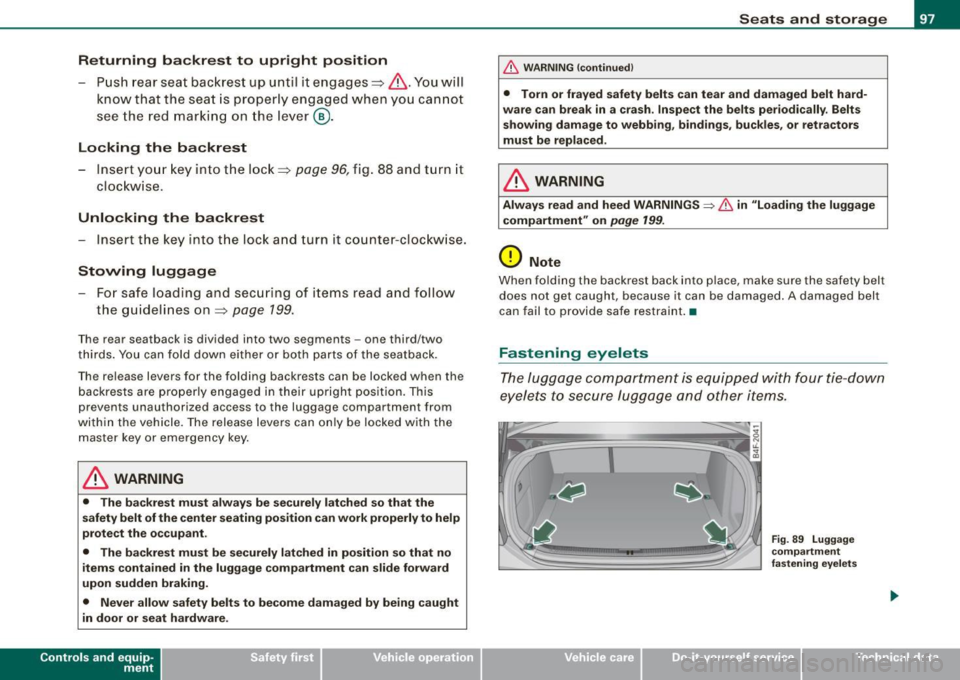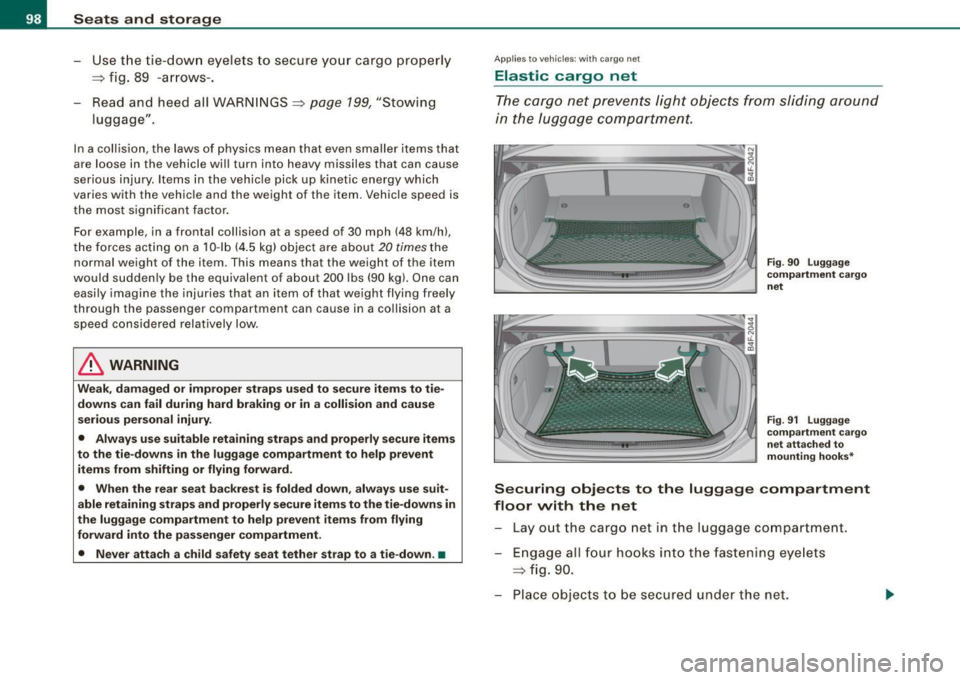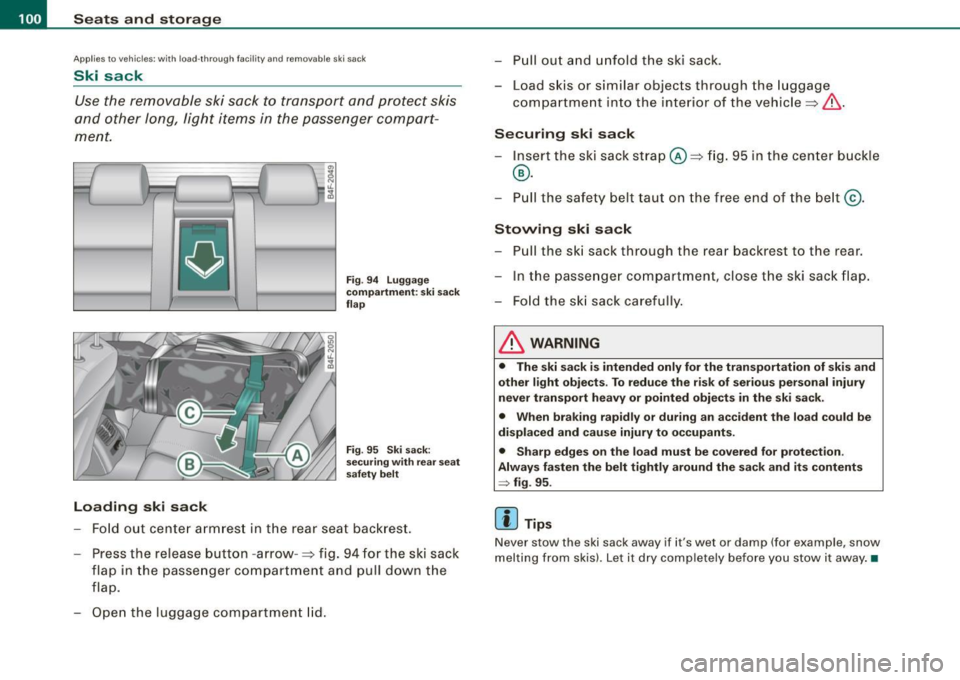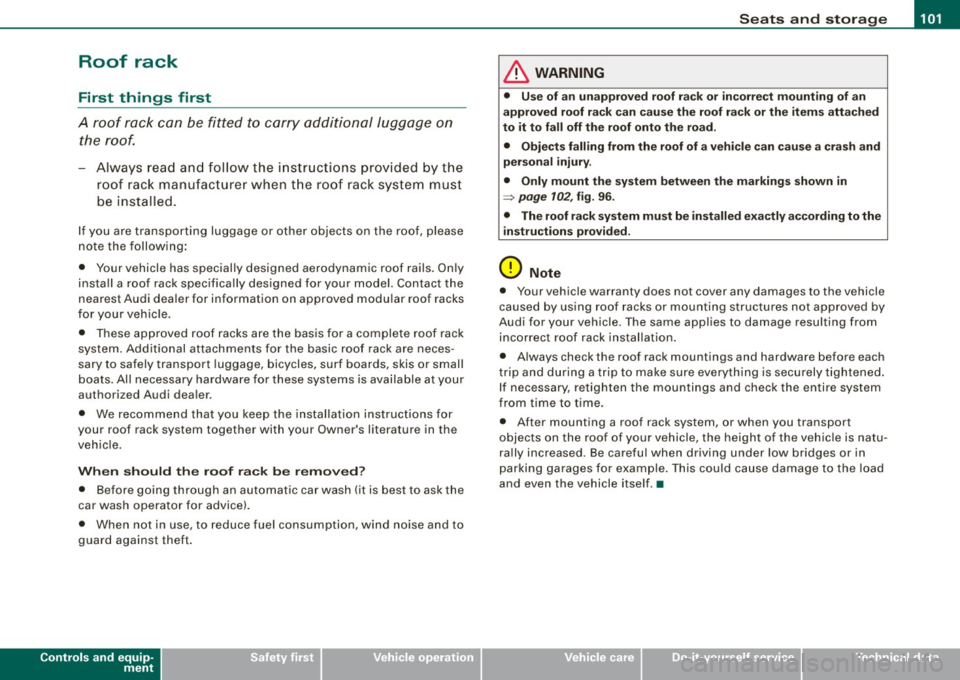2008 AUDI S6 ECU
[x] Cancel search: ECUPage 50 of 390

Opening and closing
Opening and closing
Keys
Key set
Fig . 29 Key s et
@ Ma ster key with remote control
You can centrally lock and unlock your vehicle and start the engine
with the master key with remote control.
@ Valet k ey
The valet key only fits the lock in the d river's door and the ignition
lock . If you have to leave the key with somebody else, you are well
advised to turn over the valet key only .
Be aware that the rear lid and glove compartment can be opened
from inside the vehicle using the release buttons . It is therefore best
t o activate the valet key func tion to prevent unauthorized access to
the g love compartment and the luggage compartment when
someone else has charge of your vehicle =>
page 57.
© Emergency key
The emergency key is on ly for temporary use i f the vehicle key
should be lost or misplaced =>& .
Key replacement
If you lose a key, contact your authorized Audi dea ler immediately
to have the
lost key disab led. Be sure to br ing all your keys w ith you .
& WARNING
• Do not leave your veh icle unattended w ith the key i n th e ig ni
tion lock . Entry by unauthori zed person s could endanger you or
re sult in theft or damage the vehicle. Alway s lock all door s and
take the ke y.
• Do not l eave child ren un attended
in the vehicle , especi ally w ith
acces s to vehi cle keys . Unguarded ac ce ss to the ke ys prov ide s
children the opportunity to st art the engine and /or a ctivate vehicle
systems such as the power windows et c. Unsupervi sed oper ation
of any vehicle system by children can re sult in seriou s injury.
[ i ] Tips
• If you open the driver's door with the key lef t in the ignitio n lock,
a chime will sound . T his is your reminder to remove the key and lock
the door .
• For security reasons, replacement keys are on ly available from
Audi dea lers .•
Page 55 of 390

Unlocking the vehicle with the remote control wi ll only unlock the
rear lid, t o
open it, the lid handle needs to be pressed .
Locking the vehi cle
You can lock the vehicle from outside e ither by using the re mote
control
or by inserting and turning the key in the drivers 's door lock.
When you
l oc k th e vehicle:
• All doors and the rear lid are locked .
• All turn signal lights w ill flash once when the car i s locked.
• T he anti -theft alarm system is activated . The horn of the anti
t hef t alarm syste m wi ll sound and the an ti-the ft alarm sys tem readi
ness light, located in the upper part of the driver's door panel, wil l
sta rt to bl ink.
• T he vehicle interior lights turn off .
Unlocking and lo cking with Ad van ced Key *
On vehicles which a re equipped with the Advan ced Key * authoriza
tion system, the doors are unlocked
wi thout a key by means o f a
proximity sensor in the door hand le. The doors are simi lar ly locked
without a key usi ng t he locking button . Each door has a prox imity
sensor and a locking button .
Power side door closer*
The vehic le is equipped with a power side door closer. When c losing
a door, you simply need to gently push on the doo r. The door wil l
then automatica lly c lose by itself~
page 56.
Automatic lo cking
The automatic locking feature locks all the vehicle doors and the
rear lid when you drive fas ter than 9 mph (15 km/h) . This funct ion
can be turned on and off in the
MMI Central lo cking Menu
~ p age 55.
You can unlock the vehicle from the inside by :
• removing the key from the ignition switch (the vehicle will auto
matica lly un lock itself) or
Controls and equip
ment
Opening and clo sing
• pressing the unlock part of the power lock sw itch rw or
pull ing the door handle (twice to open the rear doo rs) .
& WARNING
• When you lock your veh icle from outside , nobody -especially
c hildren -should remain in side the vehi cle . Re membe r, when you
lock the vehicle from the out side the windows cannot be opened
from the in side .
• When you leave the vehicle, alway s remove the ignition key and
t ak e it with you . Th is will prevent passengers (children , for
example ) from accidentally being locked in the vehicle should they
accidentally p ress the po wer lock ing s witch in the front doors .
• Do not leave children ins ide the vehicle unsupervised. In an
emergen cy it would be impo ssible to open the doors from the
outside without the key.
[ i ] Tips
• I n the eve nt of a crash with airbag deploymen t all locked do ors
wi ll be automatically un locked to give access to the vehicle occu
pan ts from the ou tside.
• I f the power lock ing system should malfunction, you can lock
each door individua lly using the vehicle key~
page 57.
• If the power locking system should fail, you can still open the
fu el t ank flap in an emerg ency ~
pag e 295.
• You are well advised not to keep va luables inside an unattended
vehic le, visible o r not. Even a properly locke d veh ic le can not provide
the security of a safe .•
I • •
Page 59 of 390

• You cannot open the doors or the rear lid from the outside
(increased security, for example when you are stopped at a red
light).
• The diodes in the power locking switches illuminate when all the
doors and the rear lid are closed and locked.
• All diodes turn dark as soon as one of the doors has been
unlocked .
• You can unlock and open the doors from the inside by pulling on
the door handle.
• If the driver's door is opened (after you have locked the vehicle
from the inside using the power locking switch), the door will
remain unlocked to prevent you from locking yourself out of your
vehicle. After you close the door, you have to lock the driver's door
again.
• If you have a crash and the airbag is activated, the doors auto
matically unlock.
& WARNING
• If you use the power locking switch with the doors closed,
remember that all the vehicle doors will lock.
• Locking doors from the inside can help prevent inadvertent
door opening during an accident and can also prevent unwanted
entry from the outside . Locked doors can, however, delay assis
tance to vehicle occupants and hold up rescue efforts from the outside in an accident or other emergency. •
Con tro ls and eq uip
ment
Opening and closing
Emergency locking
If the central locking system fails (power supply), each
door has to be locked separately.
Fig . 39 Emergency
locking of the front
passenger's door
An emergency locking mechanism is integrated in the edge
of the passenger 's door and in the rear doors (only visible
when the door is open).
Turn the cover with the ignition key and then tilt the
cover downward
=> fig. 39.
Insert the key into the inner slot and turn it to the right
(right-side doors) or the left (left -side door) as far as it can
go.
After you close the door, you will no longer be able to open it from
the outside.
The door can be opened from the inside by pulling once respectively
twice (rear doors) on the door handle. If the child safety lock is
engaged in one of the rear doors, the door has to be opened from
the outside after pulling on the handle once from the inside .•
Vehicle care I I irechnical data
Page 99 of 390

Returning backrest to upright position
-Pu sh rear seat back rest up until it engages~ &. You will
know that the sea t is proper ly engaged when you can not
see the red marki ng on the lever ®·
Locking the backrest
- Insert yo ur key into t he lock~ page 96, fig. 88 and t urn it
cloc kwise.
Unlocking the backrest
- Inse rt th e key i nto the lock a nd tu rn it co unter-cloc kw ise.
Stowing luggage
- For safe loading and securing of i tems read and follow
the guidelines on~ page 199.
The rear seatback is divided into two segments -one thi rd/two
thirds . You can fold down either or both parts o f the seatback.
T he release levers for the fold ing backrests can be locked when the
backrests are pro pe rly engaged in their up right pos itio n. This
prevents unauthorized access to the luggage compartment from
with in the veh icle. The release levers can on ly be locked with the
master key or emer gency key.
& WARNING
• The ba ck rest must al ways be securely lat ched so that the
safety b elt of the center seating position can work properly to help
protect the o ccupant .
• The backre st must be securely latched in po sition so that no
items contained in the luggage compartment can slide forward
upon sudden brak ing .
• Never allow safety belt s to be come damaged by being caught
in door or seat hardware .
Con tro ls and eq uip
ment
Seats and storag e
& WARNING !continued )
• Torn or frayed safety belts can tear and damaged belt hard
ware can b reak in a cra sh . Inspect the belts periodically . B elt s
showing damage to webbing , bindings, buckles , or retractor s
must be replaced .
& WARNING
Always read and heed WARNINGS ::::;, & in "Loading the luggage
c ompartment " on
page 199.
(D Note
When fo lding the backrest back into p lace, make sure the safety belt
does not get caught, because it can be damaged. A damaged belt
can fail to provide safe restraint . •
Fastening eyelets
T he luggage compartment is equipped with four tie -down
eyelets to secure lugga ge and other items.
Vehicle care I I
Fig . 8 9 Luggage
co mp artment
fastening eye lets
irechnical data
Page 100 of 390

Seats and storage
- Use the tie-down eyelets to secure your cargo properly
=> fig. 89 -arrows-.
Read and heed all WARNINGS=>
page 199, "Stowing
luggage".
In a collision, the laws of physics mean that even smaller items that
are loose in the vehicle will turn into heavy missiles that can cause
serious injury. Items in the vehicle pick up kinetic energy which
varies w ith the vehicle and the weight of the item. Vehicle speed is
the most significant factor.
For example , in a frontal collision a t a speed of 30 mph (48 km/h),
the forces acting on a 10 -lb (4.5 kg) object are about
20 times the
normal weight of the item . This means that the weight of the item
would suddenly be the equivalent of about 200 lbs (90 kg). One can
easily imagine the injuries that an item of that weight flying freely
through the passenger compartment can cause in a collision at a
speed considered relatively low .
& WARNING
Weak, damaged or improper straps used to secure items to tie
downs can fail during hard braking or in a collision and cause
serious personal injury.
• Always use suitable retaining straps and properly secure items
to the tie-downs in the luggage compartment to help prevent
items from shifting or flying forward.
• When the rear seat backrest is folded down, always use suit
able retaining straps and properly secure items to the tie-downs in
the luggage compartment to help prevent items from flying
forward into the passenger compartment.
• Never attach a child safety seat tether strap to a tie-down. •
App lies to veh ic les: with cargo net
Elastic cargo net
The cargo net prevents light objects from sliding around
in the luggage compartment.
Fig . 90 Luggage
compartment cargo
net
Fig. 91 Luggage
compartment cargo
net attached to
mounting hooks*
Securing objects to the luggage compartment
floor with the net
Lay out the cargo net in the luggage compartment .
Engage all four hooks into the fastening eyelets
=> fig. 90.
Place objects to be secured under the net.
Page 101 of 390

Configuring the net to restrain small objects
-Lay out the cargo net in the luggage compartment.
- Engage the hooks on the cargo net in the fastening eyelets in the floor at the rear of the luggage compart
ment =>
page 98 , fig. 91.
Pull down the mounting hooks -arrows- located below
the base of the rear window.
- Connect each loop on the net to the corresponding hook
as illustrated.
- Place items inside the net.
Mounting hooks*
There are two mounting hooks under the base of the rear window
inside the luggage compartment. You can attach the cargo net as
well as
light objects to these hooks.
The mounting hooks are spring -loaded and will return to their
normal position when not in use .
& WARNING
For strength-related reasons, the mounting hooks can only be
used to secure objects weighing up to 10 lb. (5 kgl. Heavier objects
will not be adequately secured -there is a risk of injury. •
Con tro ls and eq uip
ment
Seats and storage
Left-side compartment
The DVD player for the navigation system* is in the left
side storage comportment.
• •
Fig . 92 Luggage
compartment : storage
compartment for DVD
player
Fig . 93 Luggage
compartment : DVD
player for the naviga
tion system
-To open, pull the handle forward => fig. 92.
CD-ROM player for Navigation System*
The CD-ROM playe r for the navigation system~ fig. 93 is located in
this storage compartment in the luggage compartment. Operation
is described in the instructions for the audio system. •
Vehicle care I I irechnical data
Page 102 of 390

-L---S=..:: e...:a :.. t::..: s:......: a::..: n~ d:...:: s...:t ...:o ...:r...: a:.:..: g~ e ________________________________________________ _
Applies to vehicles: wi th load- through facility and removab le s ki sack
Ski sack
Use the removable ski sack to transport and protect skis
and other Jong, light items in the passenger compart
ment.
Loading ski sack
Fig . 94 Luggage
compartment: ski sack
flap
Fig . 95 Ski sack:
securing with rear seat
safety belt
Fold out center armrest in the rear seat backrest.
- Press the release button -arrow -=> fig. 94 for the ski sack
flap in the passenger compartment and pull down the
flap.
- Open the luggage compartment lid. -
Pull out and unfold the ski sack.
- Load skis or similar objects through the luggage
compartment into the interior of the vehicle =>
&-
Securing ski sack
- Insert the ski sack strap@=> fig. 95 in the center buckle
@.
- Pull the safety belt taut on the free end of the belt @.
Stowing ski sack
- Pull the ski sack through the rear backrest to the rear.
- In the passenger compartment, close the ski sack flap.
- Fold the ski sack carefully.
& WARNING
• The ski sack is intended only for the transportation of skis and
other light objects . To reduce the risk of serious personal injury
never transport heavy or pointed objects in the ski sack.
• When braking rapidly or during an accident the load could be
displaced and cause injury to occupants.
• Sharp edges on the load must be covered for protection .
Always fasten the belt tightly around the sack and its contents
~ fig. 95 .
[ i ] Tips
Never stow the ski sack away if it's wet or damp (for example, snow
melting from skis). Let it dry completely before you stow it away. •
Page 103 of 390

__________________________________________________ S_ e_ a_t _s _ a_n_ d_ s_ t_ o _r_a ..;:g::... e __ lJII
Roof rack
First things first
A roof rack can be fitted to carry additional luggage on
the roof.
- Always read and follow the i nstructions provided by the
roof rack manufacturer when t he roof rack system must
be installed.
If you are transporting luggage or other objects on the roof, please
note the following:
• Your vehicle has specially designed aerodynamic roof rails. On ly
install a roof rack specifically designed for your model. Contact the
nearest Audi dealer for information on approved modu lar roof racks
f or your vehicle.
• These approved roof racks are the basis for a complete roof rack
system. Addit ional attachments for the basic roo f rack are neces
sary to safely transport luggage, bicycles, surf boards, skis or small
boats . All necessary hardware for these systems is availab le at your
authori zed Audi dealer.
• We recommend that you keep the installation instructions for
your roof rack system together with your Owner's literature in the
veh ic le.
Wh en should th e roof ra ck b e remo ved?
• Before going through an automatic car wash (it is best to ask the
car wash operator for advice).
• When not in use, to reduce fuel consumption, wind noise and to
guard against theft .
Controls and equip
ment
& WARNING
• Use of an unappr oved roof r ack or in corre ct mounting of an
a pp ro ved roof r ack can cau se the roof rack or the ite ms attached
t o it t o fa ll off th e ro of ont o th e road .
• Obj ec ts falling fr om the roof of a v ehic le can c au se a cr ash and
per son al inju ry.
• Onl y mo unt th e sys te m betwe en the marking s shown in
=> page 102, fig. 9 6.
• The roo f rack sy stem mu st be in sta lled e xactly acc ording t o the
in stru ctio ns pr ov ided .
0 Note
• Your vehicle warranty does not cover any damages to the vehicle
caused by using roof racks or moun ting structures not approved by
Audi for your vehicle. The same applies to damage resulting from
incorrect roof rack installation.
• Always check the roof rack mountings and hardware before each
trip and during a trip to make sure everything is securely tightened .
If necessary , retighten the mountings and check the entire system
from time to time.
• After mounting a roof rack system, or when you transport
objects on the roof of your vehicle, the height of the vehic le is natu
ra lly increased . Be careful when driving under low bridges or in
parking garages for examp le . This could cause damage to the load
and even the vehicle itself. •
I • •